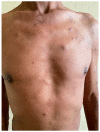Clinical Improvement of Disseminated Acanthamoeba Infection in a Patient with Advanced HIV Using a Non-Miltefosine-Based Treatment Regimen in a Low-Resource Setting
- PMID: 35202219
- PMCID: PMC8874976
- DOI: 10.3390/tropicalmed7020024
Clinical Improvement of Disseminated Acanthamoeba Infection in a Patient with Advanced HIV Using a Non-Miltefosine-Based Treatment Regimen in a Low-Resource Setting
Abstract
Disseminated Acanthamoeba species infection is likely an underrecognized and underdiagnosed opportunistic infection in patients with advanced human immunodeficiency virus (HIV) disease in South Africa. It presents a unique clinical challenge in that the diagnosis can be difficult to establish and management options are limited in low-resource settings. To our knowledge, there is a paucity of literature to date on the successful use of combination treatment options for patients in low-resource settings without access to miltefosine. We present a case describing the clinical improvement of disseminated Acanthamoeba infection in a patient with advanced HIV using a non-miltefosine-based treatment regimen. The case serves to highlight that Acanthamoeba sp. infection should be considered as a differential diagnosis for nodular and ulcerative cutaneous lesions in patients with advanced HIV in South Africa, and that although there are alternative options for combination treatment in countries without access to miltefosine, efforts should be made to advocate for better access to miltefosine for the treatment of acanthamoebiasis in South Africa.
Keywords: HIV; acanthamoeba; amphotericin B deoxycholate; miltefosine; opportunistic infections.
Conflict of interest statement
The authors declare no conflict of interest.
Figures









Similar articles
-
Disseminated Acanthamoeba infection in a heart transplant recipient treated successfully with a miltefosine-containing regimen: Case report and review of the literature.Transpl Infect Dis. 2017 Apr;19(2):10.1111/tid.12661. doi: 10.1111/tid.12661. Epub 2017 Mar 6. Transpl Infect Dis. 2017. PMID: 28067969 Free PMC article. Review.
-
Successful treatment of disseminated Acanthamoeba sp. infection with miltefosine.Emerg Infect Dis. 2008 Nov;14(11):1743-6. doi: 10.3201/eid1411.070854. Emerg Infect Dis. 2008. PMID: 18976559 Free PMC article.
-
Diagnosis of Acanthamoeba infection by cutaneous manifestations in a man seropositive to HIV.J Am Acad Dermatol. 1992 Feb;26(2 Pt 2):352-5. doi: 10.1016/0190-9622(92)70054-j. J Am Acad Dermatol. 1992. PMID: 1569257
-
Disseminated cutaneous acanthamebiasis: a case report and review of the literature.Cutis. 2004 Apr;73(4):241-8. Cutis. 2004. PMID: 15134324 Review.
-
Minimal Cerebrospinal Fluid Concentration of Miltefosine despite Therapeutic Plasma Levels during the Treatment of Amebic Encephalitis.Antimicrob Agents Chemother. 2019 Dec 20;64(1):e01127-19. doi: 10.1128/AAC.01127-19. Print 2019 Dec 20. Antimicrob Agents Chemother. 2019. PMID: 31685474 Free PMC article.
Cited by
-
The Immunological Changes in the Skin of BALC/c Mice with Disseminated Acanthamoebiasis.Pathogens. 2023 Apr 22;12(5):631. doi: 10.3390/pathogens12050631. Pathogens. 2023. PMID: 37242301 Free PMC article.
-
Extracellular Vesicles Secreted by Acanthamoeba culbertsoni Have COX and Proteolytic Activity and Induce Hemolysis.Microorganisms. 2023 Nov 14;11(11):2762. doi: 10.3390/microorganisms11112762. Microorganisms. 2023. PMID: 38004773 Free PMC article.
-
The role of apoptosis and oxidative stress in the pathophysiology of Acanthamoeba spp. infection in the kidneys of hosts with different immunological status.Parasit Vectors. 2023 Dec 1;16(1):445. doi: 10.1186/s13071-023-06052-0. Parasit Vectors. 2023. PMID: 38041167 Free PMC article.
References
-
- Lastovica A.J. Isolation, distribution and disease potential of Naegleria and Acanthamoeba (order: Amoebida) in South Africa. Trans. Roy. Soc. S. Afr. 1980;44:269–278. doi: 10.1080/00359198009520567. - DOI
Publication types
LinkOut - more resources
Full Text Sources

